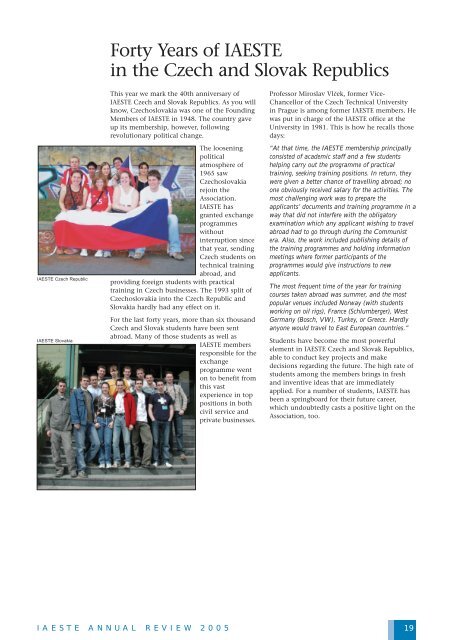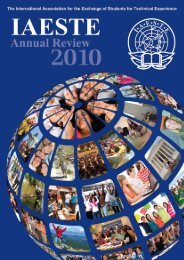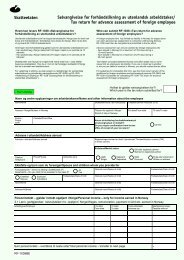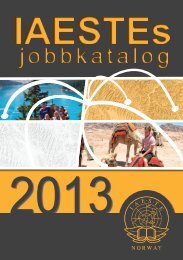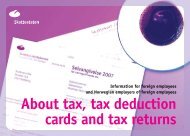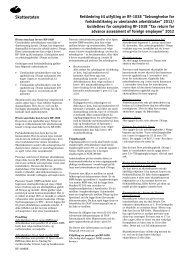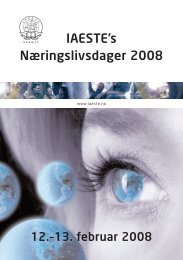View Annual Review - IAESTE
View Annual Review - IAESTE
View Annual Review - IAESTE
Create successful ePaper yourself
Turn your PDF publications into a flip-book with our unique Google optimized e-Paper software.
Forty Years of <strong>IAESTE</strong><br />
in the Czech and Slovak Republics<br />
<strong>IAESTE</strong> Czech Republic<br />
<strong>IAESTE</strong> Slovakia<br />
This year we mark the 40th anniversary of<br />
<strong>IAESTE</strong> Czech and Slovak Republics. As you will<br />
know, Czechoslovakia was one of the Founding<br />
Members of <strong>IAESTE</strong> in 1948. The country gave<br />
up its membership, however, following<br />
revolutionary political change.<br />
The loosening<br />
political<br />
atmosphere of<br />
1965 saw<br />
Czechoslovakia<br />
rejoin the<br />
Association.<br />
<strong>IAESTE</strong> has<br />
granted exchange<br />
programmes<br />
without<br />
interruption since<br />
that year, sending<br />
Czech students on<br />
technical training<br />
abroad, and<br />
providing foreign students with practical<br />
training in Czech businesses. The 1993 split of<br />
Czechoslovakia into the Czech Republic and<br />
Slovakia hardly had any effect on it.<br />
For the last forty years, more than six thousand<br />
Czech and Slovak students have been sent<br />
abroad. Many of those students as well as<br />
<strong>IAESTE</strong> members<br />
responsible for the<br />
exchange<br />
programme went<br />
on to benefit from<br />
this vast<br />
experience in top<br />
positions in both<br />
civil service and<br />
private businesses.<br />
Professor Miroslav Vlček, former Vice-<br />
Chancellor of the Czech Technical University<br />
in Prague is among former <strong>IAESTE</strong> members. He<br />
was put in charge of the <strong>IAESTE</strong> office at the<br />
University in 1981. This is how he recalls those<br />
days:<br />
“At that time, the <strong>IAESTE</strong> membership principally<br />
consisted of academic staff and a few students<br />
helping carry out the programme of practical<br />
training, seeking training positions. In return, they<br />
were given a better chance of travelling abroad; no<br />
one obviously received salary for the activities. The<br />
most challenging work was to prepare the<br />
applicants’ documents and training programme in a<br />
way that did not interfere with the obligatory<br />
examination which any applicant wishing to travel<br />
abroad had to go through during the Communist<br />
era. Also, the work included publishing details of<br />
the training programmes and holding information<br />
meetings where former participants of the<br />
programmes would give instructions to new<br />
applicants.<br />
The most frequent time of the year for training<br />
courses taken abroad was summer, and the most<br />
popular venues included Norway (with students<br />
working on oil rigs), France (Schlumberger), West<br />
Germany (Bosch, VW), Turkey, or Greece. Hardly<br />
anyone would travel to East European countries.”<br />
Students have become the most powerful<br />
element in <strong>IAESTE</strong> Czech and Slovak Republics,<br />
able to conduct key projects and make<br />
decisions regarding the future. The high rate of<br />
students among the members brings in fresh<br />
and inventive ideas that are immediately<br />
applied. For a number of students, <strong>IAESTE</strong> has<br />
been a springboard for their future career,<br />
which undoubtedly casts a positive light on the<br />
Association, too.<br />
I A E S T E A N N U A L R E V I E W 2 0 0 5 19


